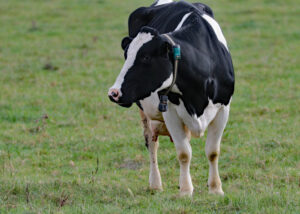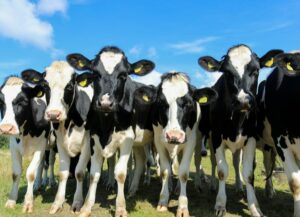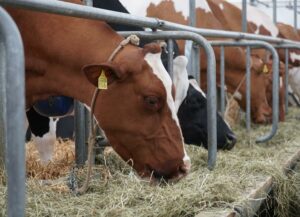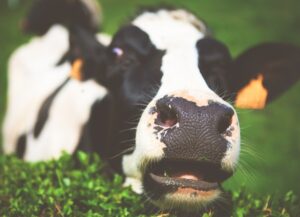Alvaro Garcia
According to the National Animal Health Monitoring System, lameness is the first reason for cows, losses followed by mastitis. Research has shown that nearly one-third of the total water absorbed by the hoof happens during the first hour of exposure to high moisture resulting in heavier and softer hooves. As a result, the presence of mud or accumulated manure are among the predisposing causes for cattle lameness. Hoof lesions represent 90% of lameness cases and can be divided in noninfectious lesions (e.g. sole hemorrhage, sole ulcer, or white line disease) and infectious lesions (digital dermatitis and foot rot). Insufficient bedding or poor-quality bedding can make both problems worse.
The time cows spend lying down is reduced as bedding decreases. When cows remain standing for prolonged periods of time, they bear weight longer on their feet and are thus more susceptible to hoof lesions. The average cow needs at least 12 hours of resting time with high-performing animals benefiting from at least 14 hours. To evaluate if cows are comfortable, one can use the cow comfort index, or the proportion of cows lying down in the stalls.
Whenever they are not eating or being milked, at least 85 percent of the cows should be lying down. The stall standing index is also important. It is the proportion of cows standing that are at least touching a stall (those perching or with just the two front feet in the stall are in this group). Less than 20 per cent of the cows should be in this category. The key then is for producers to reach an equilibrium by having enough bedding to optimize cow comfort, especially since adequate bedding is a factor in preventing lameness. Lameness has also been associated with negative reproductive performance in dairy cows. It is very possible that hoof lesions affect reproduction through inflammatory and stress response. It has been shown that inflammation affects the release of reproduction hormones from the hypothalamus-pituitary-ovarian axis.
A recent study (Omontese et at., 2020) evaluated the relationship between hoof lesions and reproductive outcomes in lactating Jersey (and its crosses) cows. The researchers had two main objectives: the first was to evaluate the association between hoof lesions in early lactation and the resumption of ovarian activity, interval from calving to first service, pregnancy per insemination, and pregnancy loss to first service. The second objective was to evaluate the association between the development of hoof lesions and pregnancy at 150 days in milk (DIM).
Cows were housed in a cross-ventilated freestall barn with stalls bedded with recycled sand; the alleys had grooved concrete flooring and were scraped 3 times per day. Cows were milked 3 times daily, and fed a TMR (corn silage, alfalfa hay, and concentrates) with free access to water. A combination of estrus detection and timed AI was used for fertility management in the herd. After a 35 days of voluntary wait period, cows were administered 3 injections of prostaglandin F2α 14 days apart at 41 ± 3, 55 ± 3, and 69 ± 3 DIM. Cows were inseminated if estrus was observed. Cows not detected in estrus were bred using the 5-d Cosynch-72 protocol at 81 ± 3 DIM (GNRH followed by followed by injections of prostaglandin F2α 5 and 6 days later, and a final injection of GNRH at timed AI). Cows were evaluated for BCS at days 20 and 120. Cows were classified at day 20 as with a healthy hoof or having hoof lesions. Those with hoof lesions were further classified as having non-infectious (sole hemorrhage, sole ulcer, toe ulcer, or white line disease), or infectious hoof lesion (digital dermatitis and foot rot).
Cows with hoof lesions at day 20 postpartum:
- Had less chance of being cyclic (38.3 vs. 51.9%) and longer interval from calving to first service (58 vs. 51 days).
- Those with infectious hoof lesions had less chance of becoming pregnant at the first service (16.7 vs. 38.3%).
- With sole hemorrhages they were more likely to lose their pregnancy between days 32 and 64 after the first service (10.5 vs. 5.2%). They also had a smaller hazard of pregnancy (67.9 vs. 75.5%) at 150 days in milk and more days open (88 vs. 77days).
To test the relationship between hoof lesions and fertility, cows were classified four groups:
- Healthy (no hoof lesion at days 20 and 120).
- Cured (any hoof lesion at day 20 and no hoof lesion on day 120).
- New hoof lesion (no hoof lesion at day 20, and any hoof lesion at day 120).
- Chronic (any hoof lesion at days 20 and 120).
The great majority (93%) of new hoof lesions were sole hemorrhages. Cows with sole hemorrhage in early lactation had a smaller pregnancy hazard than healthy. There was no difference in pregnancy hazard at 150-DIM between cows that remained healthy and cows that developed new hoof lesions. Hoof lesions at day 20 were associated with decreased odds of cyclicity, longer interval from calving to first service postpartum, and reduced pregnancy hazard. Overall cyclicity was reduced in cows with hoof lesion in early lactation, irrespective of the type of lesion.
Reference
Omontese, B.O., Bellet-Elias, R., Molinero, A., Catandi, G.D., Casagrande, R., Rodriguez, Z., … Cramer, G. 2020. Association between hoof lesions and fertility in lactating Jersey cows. Journal of Dairy Science. 103: 3401-3413.
© 2020 Dairy Knowledge Center. All Rights Reserved.









